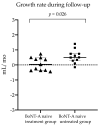Reduced Cross-Sectional Muscle Growth Six Months after Botulinum Toxin Type-A Injection in Children with Spastic Cerebral Palsy
- PMID: 35202166
- PMCID: PMC8876834
- DOI: 10.3390/toxins14020139
Reduced Cross-Sectional Muscle Growth Six Months after Botulinum Toxin Type-A Injection in Children with Spastic Cerebral Palsy
Abstract
Botulinum Neurotoxin type-A (BoNT-A) injections are widely used as first-line spasticity treatment in spastic cerebral palsy (SCP). Despite improved clinical outcomes, concerns regarding harmful effects on muscle morphology have been raised. Yet, the risk of initiating BoNT-A to reduce muscle growth remains unclear. This study investigated medial gastrocnemius (MG) morphological muscle growth in children with SCP (n = 26, median age of 5.2 years (3.5)), assessed by 3D-freehand ultrasound prior to and six months post-BoNT-A injections. Post-BoNT-A MG muscle growth of BoNT-A naive children (n = 11) was compared to (a) muscle growth of children who remained BoNT-A naive after six months (n = 11) and (b) post-BoNT-A follow-up data of children with a history of BoNT-A treatment (n = 15). Six months after initiating BoNT-A injection, 17% decrease in mid-belly cross-sectional area normalized to skeletal growth and 5% increase in echo-intensity were illustrated. These muscle outcomes were only significantly altered when compared with children who remained BoNT-A naive (+4% and -3%, respectively, p < 0.01). Muscle length growth persevered over time. This study showed reduced cross-sectional growth post-BoNT-A treatment suggesting that re-injections should be postponed at least beyond six months. Future research should extend follow-up periods investigating muscle recovery in the long-term and should include microscopic analysis.
Keywords: 3D freehand ultrasound; botulinum neurotoxin type-A; muscle growth rate; spastic cerebral palsy.
Conflict of interest statement
The authors declare no conflict of interest.
Figures





References
-
- Willerslev-Olsen M., Choe Lund M., Lorentzen J., Barber L., Kofoed-Hansen M., Nielsen J.B. Impaired Muscle Growth Precedes Development of Increased Stiffness of the Triceps Surae Musculotendinous Unit in Children with Cerebral Palsy. Dev. Med. Child Neurol. 2018;60:672–679. doi: 10.1111/dmcn.13729. - DOI - PubMed

